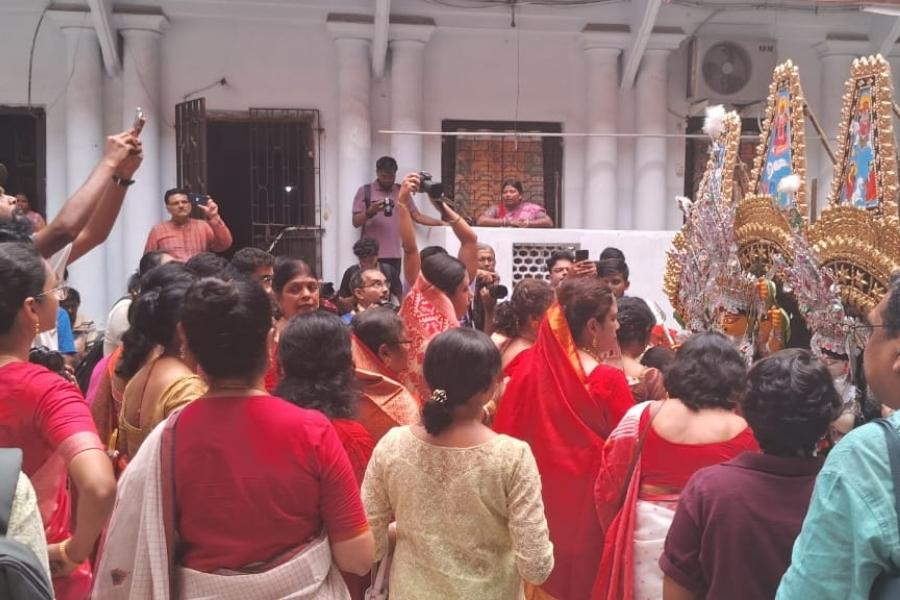The tale of the Mitra family’s puja dates back more than two centuries, beginning with Kali Puja, first observed in the household 232 years ago, and followed 13 years later by Durga Puja, now in its 219th year. “Our Kali Puja is 232 years old, and Durga Puja began 219 years ago, once our ancestor Radha Kissen Mitra completed the family tradition. These rituals have been passed down generation to generation, and we are now the ninth generation carrying them forward,” shares Soumyajit Mitra with quiet pride, standing at the family’s ancestral home on Nilmoni Mitra Street.
Rituals that define tradition
Unlike many other household pujas, the Darjipara Mitra Bari puja is marked by distinct practices. One of the most striking is the daily Kumari Puja, where young girls are worshipped as embodiments of the goddess herself. “In our puja, Kumari Puja is not a one-day event. We perform it every single day to honour the divine feminine in its purest form,” explains Anushua Mitra Biswas, who oversees much of the preparation behind the scenes.
Another hallmark is how the sacred fire of the ‘hom’ is ignited. Instead of relying solely on the priest, the family lights the flame. “We light a small fire ourselves and pass it on to the purohit, who then carries out the rituals. It is symbolic, reminding us that the puja is initiated and rooted in the family itself,” adds Anushua.
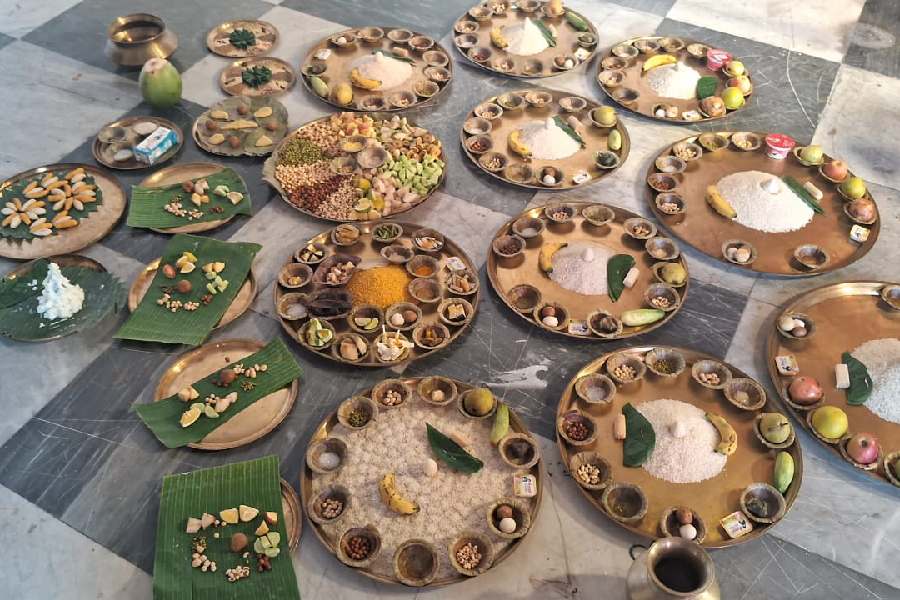
From frying moong dal in ghee until it glows golden, to arranging an array of papad, pickles, and traditional bhog, every detail is handled with devotion by the family’s women across three generations
The rituals extend into food offerings prepared entirely within the household. From frying moong dal in ghee until it glows golden, to arranging an array of papad, pickles, and traditional bhog, every detail is handled with devotion by the family’s women across three generations.
Icons of power and grace
One of the most striking features of the Darjipara Mitra Bari Durga idol is the lion. Unlike the traditional form, here, the lion bears the face of a horse. The family explains that this is not a mistake, but a symbol. The lion represents unmatched strength, while the horse signifies speed. The blend of the two, painted in white, signifies the power of the lion combined with the swiftness of the horse. The colour itself is deliberate — a nod to the belief that lions roaming the snow-capped Himalayas would naturally be white.
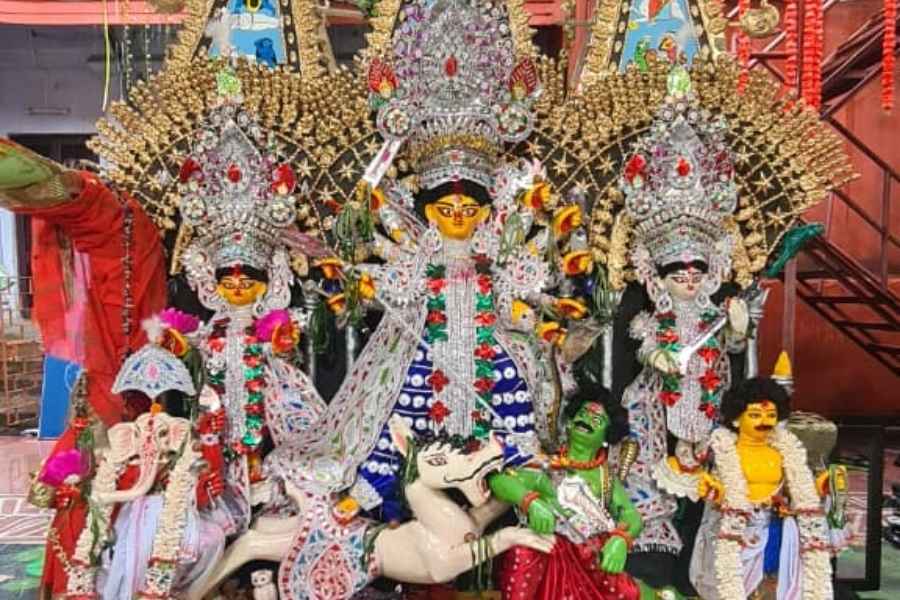
Unlike the traditional form, here, the lion bears the face of a horse. The family explains that this is not a mistake, but a symbol
The uniqueness extends to the idols of Kartik and the Asura, whose human faces mark them apart from conventional representations. These flourishes lend the puja an unmistakable identity in Kolkata’s Bonedi Bari circuit.
Food, festivity and family
The Durga Puja at Mitra Bari is also marked by elaborate community feasts. On the eighth day, vegetarian dishes dominate the table, but from the ninth day onwards, fish becomes central to the meals. “On the ninth day, we eat Rohu and Katla fry, while on the tenth, before the bhajans, we eat fish before Boron. These have become part of our rhythm of celebration,” says Soumyajit.
Beyond the food, the puja is an anchor for family togetherness. Relatives from near and far gather under one roof. “During puja, everyone tries to come home — the brothers, sisters, their children. It becomes the one moment in the year when the family truly gathers, sharing rituals, meals and memories,” he says.
Continuity amid change
While traditions remain sacred, the puja has also embraced newer dimensions. In 2024, the Darjipara Mitra Bari Durga Puja had the honour of hosting the Kolkata Knight Riders’ IPL trophy on Saptami, with Priyam Ghosh carrying the gleaming cup into the house. The moment became a proud convergence of sports, culture and heritage — an affirmation that the puja continues to resonate across generations and communities.
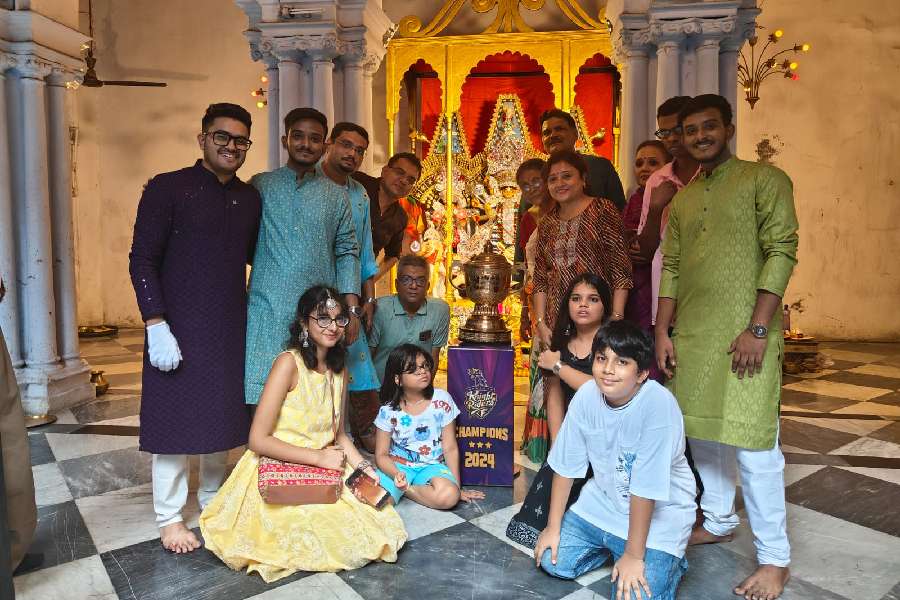
In 2024, the Darjipara Mitra Bari Durga Puja had the honour of hosting the Kolkata Knight Riders’ IPL trophy on Saptami, with Priyam Ghosh carrying the gleaming cup into the house.
Despite the evolving cityscape and the inevitable march of time, the Mitra family holds steadfast to their customs. “When I was young, I was pampered by all the elders. Today, I am proud to see how the puja has continued with the same reverence. The essence has not changed. This puja is more than worship, it is heritage,” reflects Soumyajit.
‘Boron’ and ‘Bisarjon’
At Mitra Bari, ‘boron’ is a moment of beauty. On Dashami, all the women of the household — mothers, grandmothers, sisters, daughters-in-law — dress in traditional saris to welcome and bid farewell to the goddess with ‘sindoor’ and rituals that remain timeless.
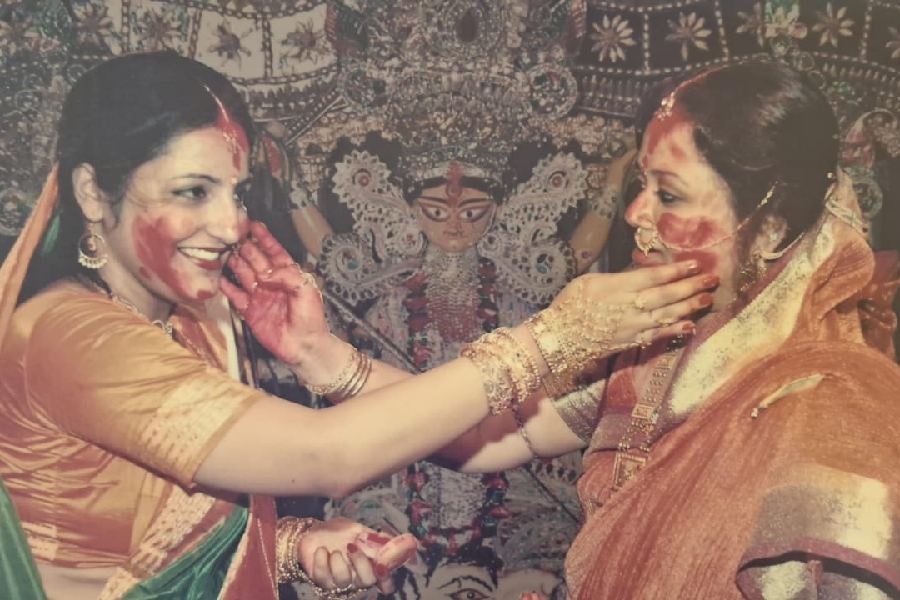
A picture from the 200th year of the Pujo at Darjipara Mitra Bari
The ‘bisarjon’ here is equally unique and deeply traditional. Unlike many household pujas, where the idol is taken away in a vehicle, at Darjipara Mitra Bari, Ma Durga is carried on the shoulders of the men of the house. Wearing dhoti and ooroni, each man holds a stick as they escort the goddess to immersion. It is a sight steeped in grace, continuity and devotion — a living tableau of heritage.
Behind the scenes
If heritage is its backbone, the women of the household are its lifeblood. Every aspect, from preparing bhog to adorning the goddess, is meticulously handled by the family. “We are lucky that our girls and women work beautifully together. Everything is done within the household. We still decorate the idol ourselves, arrange the naivedyam, prepare the puja offerings. That is what keeps the puja authentic,” explains Anushua.
A prayer for the future
At the heart of it all, the Mitra Bari Puja remains an expression of faith and hope. Each ritual, each chant, is accompanied by a simple prayer. “We tell the mother — you are Shakti, and we too are mothers and daughters. Give us the strength to fight evil, so that we may build a beautiful world and keep our family and society strong,” says Anushua.
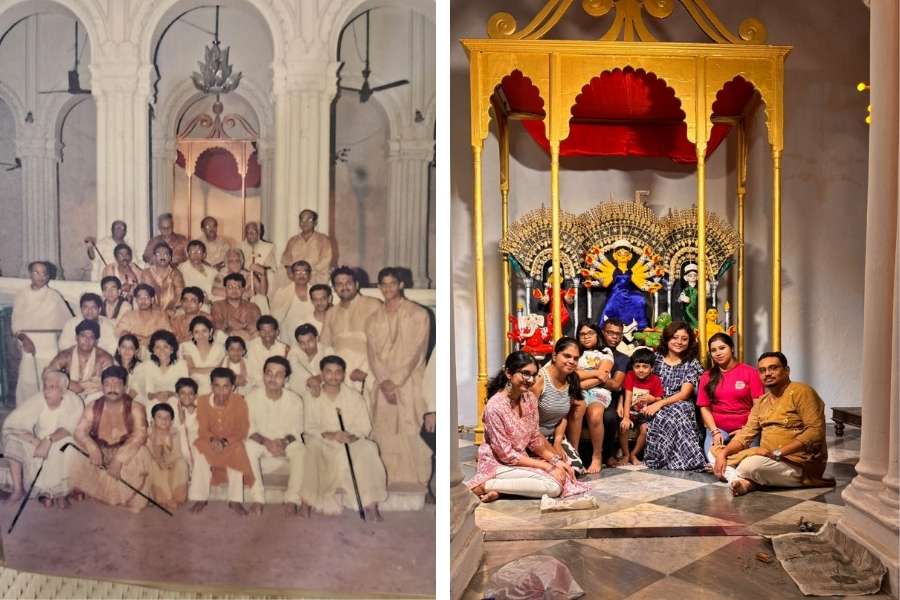
(L) A picture of the Mitra family on Dashami during their 200th Durga Puja celebration (R) A picture of the family ahead of the celebrations this year
This year, as the ninth generation steps forward, the message resonates even louder. The puja is not merely a family celebration; it is a living legacy of Kolkata’s cultural fabric, rooted in the past but alive in the present.
